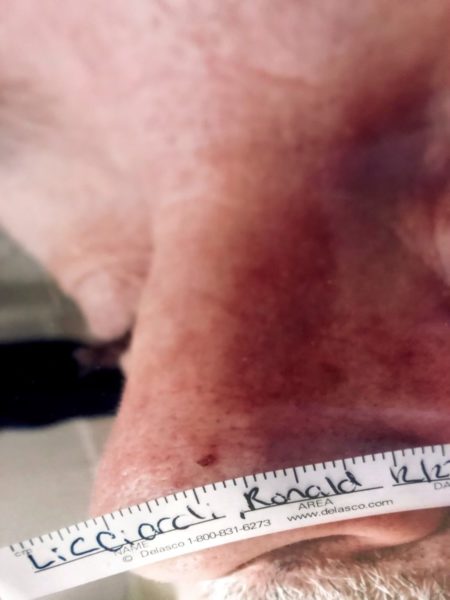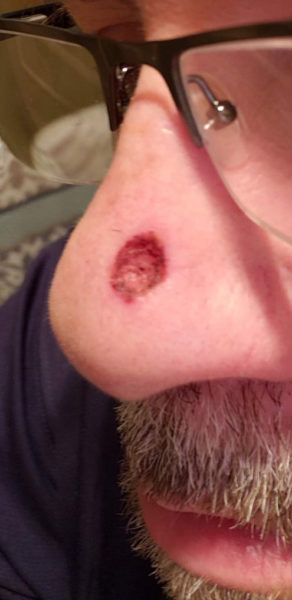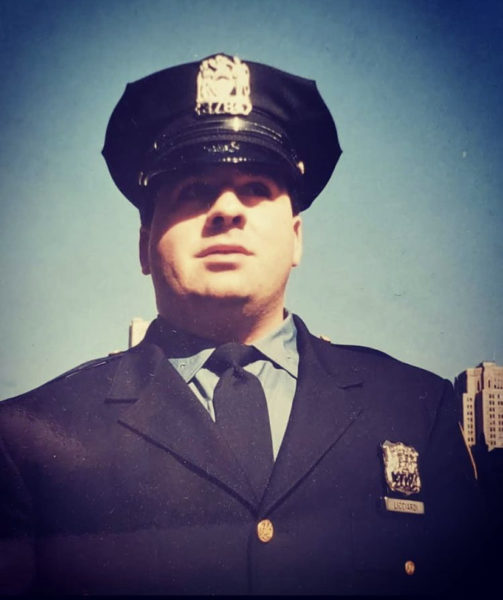Retired NYPD detective Ron Licciardi thought he had seen it all. The 9/11 first-responder spent more than 20 years looking for clues and carefully examining evidence while solving all kinds of cases. But when it came to his own skin, he learned a hard lesson about how to identify skin cancer warning signs hiding in plain sight.
In early 2019, Ron’s wife pointed out a new spot on his nose, and one on his shoulder that was changing size and color. “She said to me, ‘You know, you have to get these checked.’”
Ron was not concerned. “Skin cancer never crossed my mind,” he explained. “Thanks to her persistence, I did get checked by a dermatologist, who informed me that seeing something new or changing on your skin is an important clue that you can’t overlook.”
A short time after his skin exam, Ron’s phone rang. “It was my dermatologist, who informed me that the biopsies came back as skin cancers,” he said. “My heart sank when I heard the ‘C’ word, and I started researching online. It was encouraging to learn that this type, basal cell carcinoma, is very curable when caught early.”
 |
 |
|---|---|
| BCC before surgery | BCC after Mohs surgery |
Photos courtesy of Ron Licciardi
Ron’s dermatologist performed Mohs surgery to treat the BCC on his nose and electrosurgery to remove the one on his shoulder. “The Mohs was a precision kind of surgery, and luckily it only took one round to get the entire thing. The cancer started out as small as a freckle and I ended up with a wound the size of a dime. I’m lucky I did not wait, because if it grew any bigger, who knows what the scar would look like!”
A lifetime of sun exposure
Like most people growing up on Long Island in the 1970s, Ron did not use much sunscreen. “I went to the beach and played outdoor sports all summer long without protecting my skin,” he explained. “Sunscreen was not widely used, and I never really thought twice about sunburn.”

As a rookie officer in 1991, Ron’s hat did not protect his nose from the sun.
In the 1990s, Ron joined the NYPD, got married and started a family. All the while, his sun exposure continued – working cases, coaching his son’s baseball games and going on beach vacations and family outings. Even though the correlation between sun exposure and skin cancer was becoming more publicly understood, Ron acknowledged that sun protection was “not top of mind” during this busy time in his life.
From “lackadaisical” to “locked in”
While women are more vigilant than men about skin care and safety, new research suggests that couples can work together improve their sun protection habits. Ron admitted that over the decades, his wife did most of the sunburn prevention work, bringing the sunscreen on outings and reminding him to apply and reapply.
“Sometimes I would do it and sometimes I wouldn’t,” he said. “You could say I was a little lackadaisical about it.”
Since his diagnosis, Ron changed his ways. “Right off the bat at age 54, I had more than one skin cancer. So now I’m locked in when it comes to protecting myself,” he explained. Ron learned that a history of two or more skin cancers puts him at a much higher risk of developing further skin cancers.
“Don’t get me wrong; I still do the things that I love. But now I take extreme precautions – umbrellas, wide-brimmed hats, sun protective clothing, and of course diligent sunscreen use,”
“Don’t get me wrong; I still do the things that I love. But now I take extreme precautions – umbrellas, wide-brimmed hats, sun protective clothing, and of course diligent sunscreen use,” he said.
“You can see it, so you can do something about it.”
These days, Ron performs monthly self exams to look for anything new, changing or unusual on his skin, and asks his wife to check the hard-to-see places. “My doctor educated me about what to look for, especially when checking my scalp, my arm tattoos and other places where skin cancers can hide.” Twice a year, he sees his dermatologist for a skin cancer screening.
Now that his investigative skills include skin cancer detection, Ron shares his story and his knowledge with his large social media following. “Skin cancer is the most common cancer in the world, but unlike other cancers, you can see it, so you can do something about it. I implore everyone: check your skin and protect it from the sun. Get yourself examined professionally once a year. It could make the difference between life and death.”
#ThisIsSkinCancer
The post Hiding in Plain Sight: NYPD Veteran Uncovers Clues for Detecting Skin Cancer appeared first on The Skin Cancer Foundation.

